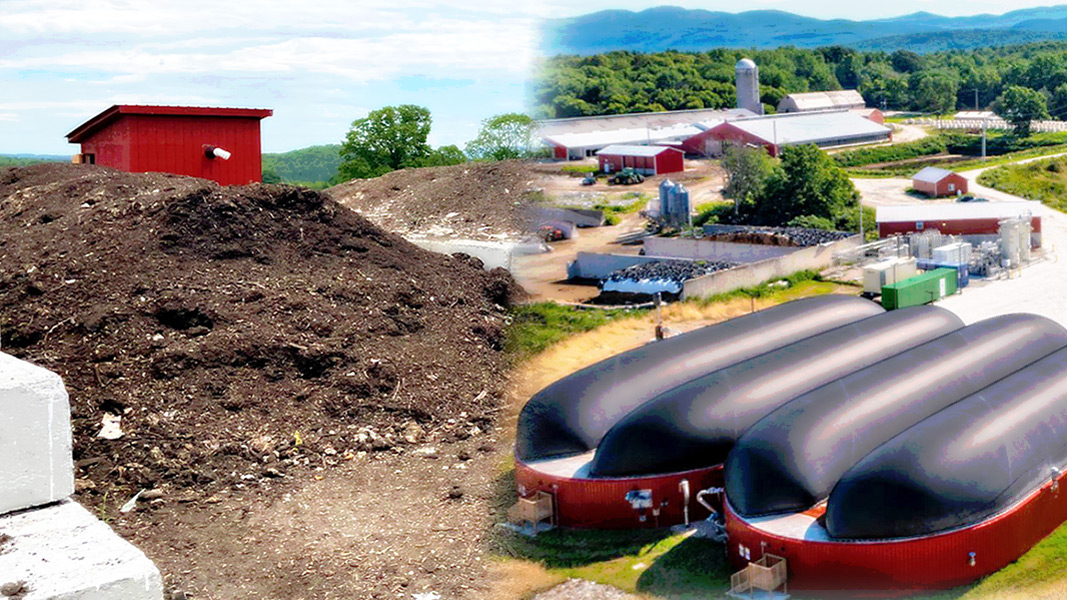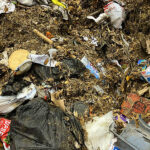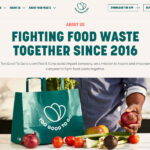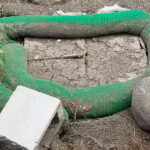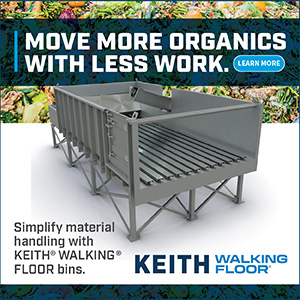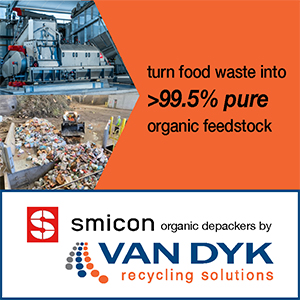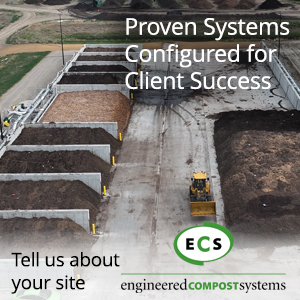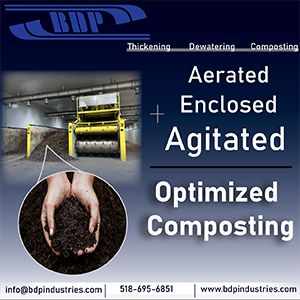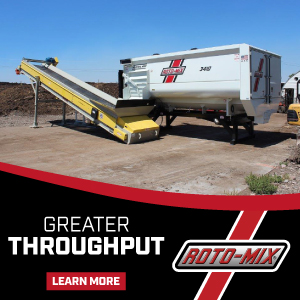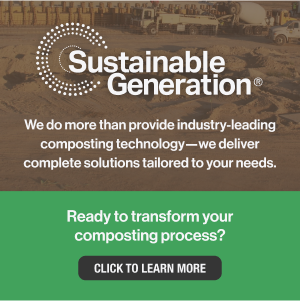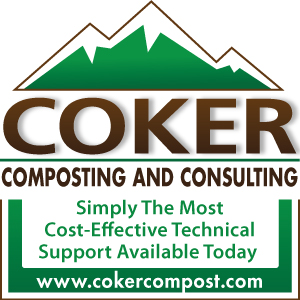Top: Food scraps are managed in Vermont primarily via composting and anaerobic digestion. Photos by Robert Spencer (left) and courtesy The Goodrich Family Farm (right)
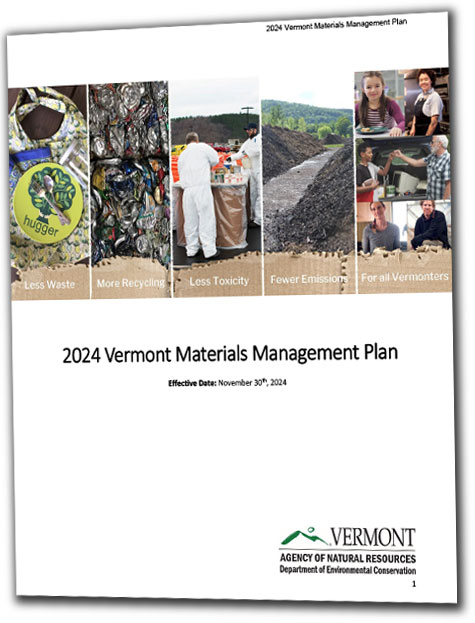 Vermont’s Universal Recycling Law (URL), which passed in 2012 and went into effect in 2014, banned disposal of food scraps, leaf and yard trimmings and clean wood waste. The law took effect in phases, starting with the largest food waste generators in the state. By July 2020, the URL was fully in effect when residential food scraps had to be diverted from disposal. Every five years, Vermont law requires the Agency of Natural Resources to update its solid waste plan. The 2024 Vermont Materials Management Plan (VMMP), released in mid-January, serves as a guide for the Agency’s and municipalities’ waste management-related actions from 2025 through 2029. The Vermont Department of Environmental Conservation’s (DEC) Solid Waste Management Program, through the Plan, outlines annual requirements for both the state and Vermont’s municipal solid waste districts, alliances, and independent towns that take responsibility for local or regional waste management. “In light of the flooding in 2023 and 2024, there are new priorities related to disaster planning and response to better prepare for future natural disasters,” said Josh Kelly, DEC Solid Waste Program Manager when the plan was released. “There are also sections connecting climate change and equity to waste management.”
Vermont’s Universal Recycling Law (URL), which passed in 2012 and went into effect in 2014, banned disposal of food scraps, leaf and yard trimmings and clean wood waste. The law took effect in phases, starting with the largest food waste generators in the state. By July 2020, the URL was fully in effect when residential food scraps had to be diverted from disposal. Every five years, Vermont law requires the Agency of Natural Resources to update its solid waste plan. The 2024 Vermont Materials Management Plan (VMMP), released in mid-January, serves as a guide for the Agency’s and municipalities’ waste management-related actions from 2025 through 2029. The Vermont Department of Environmental Conservation’s (DEC) Solid Waste Management Program, through the Plan, outlines annual requirements for both the state and Vermont’s municipal solid waste districts, alliances, and independent towns that take responsibility for local or regional waste management. “In light of the flooding in 2023 and 2024, there are new priorities related to disaster planning and response to better prepare for future natural disasters,” said Josh Kelly, DEC Solid Waste Program Manager when the plan was released. “There are also sections connecting climate change and equity to waste management.”
The organics section of the VMMP summarizes the status of the state’s diversion efforts since the URL was enacted. According to the 2023 Vermont Municipal Solid Waste Composition Study, food waste made up 18.8% (71,112 tons) of the state’s municipal solid waste stream, yard and leaf debris was 1.2% (4,489 tons) and clean wood was 1.6% (6,235 tons), by weight. “While this was not a significant percentage change in food waste from the 19.4% found in the 2018 study, the total estimated tonnage of food waste in the trash decreased by 13% from the 81,627 tons in 2018,” states the VMMP. All facilities that collect trash are required to also collect food scraps. In 2022, 129 regulated facilities reported collection of food scraps, including transfer stations, recycling centers, and compost facilities. Since 2012, the number of haulers offering food scrap collection services has more than tripled from approximately 12 to 38. “This includes haulers that specialize in food scrap collection as well as haulers that offer trash, recycling and now food scrap collection,” notes the VMMP.
As of 2023, Vermont had 11 food scrap composting facilities that are certified by DEC and operate year-round. Two anaerobic digesters (in Salisbury, owned by Vanguard Renewables, and South Burlington, owned by Purpose Energy) are permitted by DEC to accept liquified food scraps, such as from a depackaging facility near Burlington, and food manufacturers. Purpose Energy has two permitted digesters, one of which recently opened in Middlebury. Vermont’s Agency of Agriculture, Food, and Markets (AAFM) has regulatory oversight of on-farm composting operations that use most of the finished compost on their farm and/or raise chickens. As of 2023, there are 12 on-farm composting facilities that collect and compost food scraps. Spent grain, whey and other food manufacturing byproducts are commonly fed to animals at farms throughout the state. Vermont also has numerous on-farm digesters, some of which accept food processing byproducts from dairy, brewing, and other food manufacturing processes to produce electricity and heat.
In 2022, 18,681 tons of food scraps were processed, primarily through composting. An additional 6,088 tons of packaged food went through the depackaging facility to an anaerobic digester. Vermont facilities also processed approximately 10,972 tons of food processing residuals; the majority of these were sent directly from food or beverage manufacturers to anaerobic digesters. Vermont facilities reported that 4,695 tons of leaf and yard debris and 3,840 tons of clean wood were processed. Challenges related to organics collection and management in Vermont include bears and emerging contaminants like PFAS and microplastics.
The VMMP points out that although the full food scrap ban went into effect for all Vermonters in 2020, the impacts of the ban are difficult to determine due to other coinciding factors, primarily the COVID-19 pandemic. “While many composting facilities noted an increase in food scraps after the ban, the amount of food scraps reported as passing through regulated facilities decreased due to the pandemic impacts on restaurants, schools, and other food establishments,” states the plan. “The depackaging facility that began operating in 2021 also shifted material to anaerobic digestion; some food scraps had previously been going to compost facilities and some of the packaged food and food processing residuals had previously been landfilled.”
The Vermont Foodbank helps retailers set up systems where staff set aside food for donation instead of putting it in the trash. From 2014 to 2017, donations to the Foodbank almost tripled, in large part due to the URL. However, with the exception of 2020, which saw a rise in food donation due to the COVID-19 pandemic, the amount of rescued food has declined since the peak in 2017. According to the Vermont Foodbank, many factors may be contributing to this decrease in donated food including supply chain challenges, actual reductions in surplus food, and an increase in secondary markets like Aldi’s or Ocean State Job Lot that sell overstock items or liquidation centers that sell past-date items or products with damaged packaging.


